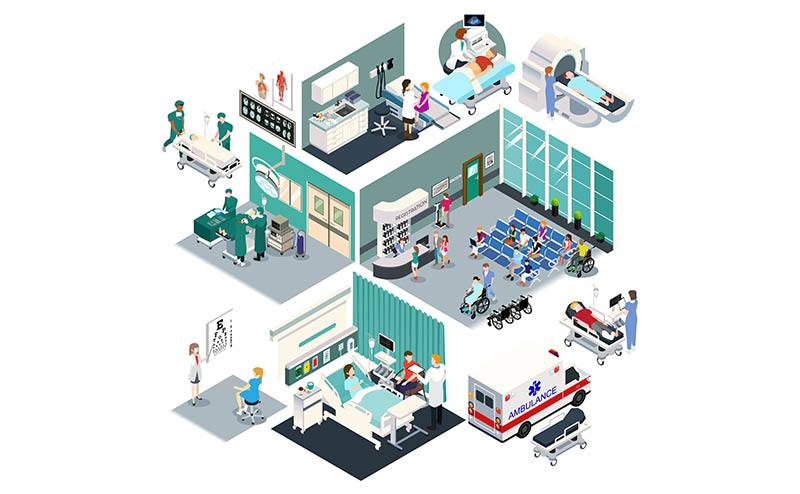
Optimizing throughput in the Emergency Department: One Institution’s experience
Peter England, MD, FACEP
As 2024 comes to an end, the QIPS leadership team would like to look forward to our plans for the section newsletter in 2025. Over the course of the next calendar year, we will focus our newsletter editions on various QIPS topics relevant to the Emergency Medicine physician practicing today. We hope to spotlight various quality improvement efforts that are happening across the country, to share recent evidence supporting such endeavors, methods and frameworks to make change and create a forum for shared ideas and discussion. This newsletter will be more successful if we are able to target topics that interest you, the reader. If you have an idea for a topic or a novel quality improvement effort that you would like us to spotlight, please reach out to Peter England with recommendations, suggestions and feedback.
Our first newsletter for 2025 will focus on Emergency Department (ED) throughput. Inpatient boarding in the ED is a plague that is burdening many emergency physicians and their patients across the nation. Inpatient boarding has direct impact on the morbidity and mortality of admitted patients1, but is also detrimental to throughput within an ED. This results in delays, preventing us from taking care of new patients seeking immediate medical care. We have seen little support from hospitals and the government to address this rapidly worsening obstacle. Our own specialty and governing body, ACEP, works on legislation in the political arena to address this epidemic, but this progress is slow. Thus, Emergency medicine physicians must adapt to these challenges to ensure the delivery of high-quality care for every patient who comes through our doors. We must reevaluate older methods of patient care and reimagine novel pathways and processes to adapt. Vertical flow, which falls under the umbrella of split flow, is an example of how we reimagine traditional methods of care in the ED. While this is not a novel concept, successful implementation can be variable and is not well shared or discussed throughout our specialty. This story is an example of novel reevaluation and more importantly, the sharing of a success story.
The traditional model of patient evaluation and treatment in the ED relies on a linear process of registering a patient, then triaging them to a stretcher in the ED where nursing and provider evaluation, resuscitation, diagnostic workup and advanced treatment can occur. This is typically followed by determining the patient’s disposition. However, limitations in physical space within the ED during times of high patient volume and excessive inpatient boarding cause this traditional model to bottleneck, resulting in backflow in the waiting room.
The concept of split flow recognizes that not all patients require a stretcher and horizontal treatment. In fact, many complaints, frequently those with an Emergency Severity Index (ESI) score of 4 or 5 can be evaluated quickly in a modified space separate from the traditional treatment area of the ED. These patients may be best managed in a “fast track” area since they are commonly ambulatory, have less acute chief complaints and typically require shorter workups. Additionally, space per patient can be truncated, as separate rooms and stretchers are not required, thus increasing the efficiency of patient evaluation and treatment. In isolation this model does help improve the evaluation of lower acuity patients2,3. The concept of a “fast track” can lead to quicker patient throughput for a subset of patients. On the opposite side of the spectrum, patients with more acute or life-threatening problems, typically ESI 1 & 2 patients, are typically triaged to quicker evaluation given the risks of delay. This leaves a large, potentially the largest, cohort of patients that is most likely to experience the longest delay in evaluation. This is the ESI 3 cohort. Many ESI 3 patients have urgent but not truly emergent complaints and thus can safely wait for evaluation. However, many EDs can increase the throughput of patients with an ESI 3 via a “vertical” flow model.
A “vertical” flow model recognizes that many patients may be able to remain sitting through their stay and do not require the space of a stretcher or room to be horizontal. Provider and nursing evaluation can occur privately in a discrete location, but the patient can wait for the results of the workup and ultimate disposition from the ED in a waiting room or other designated space, thus lifting the burden of physical space limitations within the ED.
Split and vertical flow models were recognized as a potential opportunity to have a high impact on ED crowding in the 2016 Emergency Medicine Practice Committee report4. Given this benefit many institutions across the country have instituted some form of vertical flow with varying levels of success.
The University of Maryland Medical Center’s (UMMC) experience mirrors many EDs across the country. They too had large cohorts of ESI level 3 patients with significantly long waiting room times until evaluation and a high rate of patients leaving without being seen (LWBS) by a medical provider. UMMC aimed to create a vertical flow process to address this concern, however there was no clear literature to guide implementation of such a change. The operational directions, successes and failures had been poorly described in the literature. Given this, UMMC performed a scoping review on this topic that was published in journal of Academic Emergency Medicine in 20235. Key findings from their review are summarized here:
- The most common challenge with implementation was resistance of staff to change, however this is likely to improve with regular meetings with staff to solicit input and feedback
- It is important to engage multidisciplinary stakeholders in the creation
- It is helpful to have some inclusion and exclusion criteria for the vertical zone, however some degree of ambiguity may be helpful to capture a larger cohort of patients
- Returning patients to a waiting room, either external or internal to the Emergency Department, to await results is important to expedite patient evaluation
- Scribes were noted to be helpful to improve the efficiency and engagement of providers in this area
- Significant investment in additional resources was not felt to be required for most Emergency Departments but appropriate stocking of the equipment must be secured
- Utilization of lean healthcare principals and plan-do-study-act (PDSA) cycles in the implementation process are vital to its success
- Provide visible evaluation and feedback to staff while providing “thanks” at the same time to improve engagement with the process change.
From 2021 to 2022, a multidisciplinary group of ED Physicians, Advance Practice Providers and Nurses met to develop a 3-recliner vertical flow pathway in their department, through which ESI level 3 patients could be appropriately evaluated, worked up, and dispositioned. Their work was implemented in April 2022, and within the year following the rollout of their process, they saw approximately 13% of their total ED volume come through the vertical flow pathway! They have since expanded their vertical flow model of ESI 3 patients into a Rapid Assessment Area within their department that sees appropriate ESI 2-5 patients. Over the past year alone, this Rapid Assessment Area has seen a 45% increase in the patient volume, a 28% decrease in their LWBS percentage among these patients, and a 25% reduction in the total length-of-stay of the patients seen in this area.
Dr. Falat, Assistant Professor at the University of Maryland School of Medicine, Assistant Medical Director at the University of Maryland Medical Center's Adult Emergency Department, and ACEP QIPS Section President, spoke with me about implementing this process in her department: "John Kotter's approach to change management really explains how our process has been so successful. With the nation's boarding crisis, we already all felt an inherent urgency to improve flow. The team selection was critical - including engaging team members from all roles - physicians, NPs, and nurses - really facilitated the creation of our vision, communication of our vision, and continued analysis of our vision, until our vision became steady state and the concept of change became a new cultural normal within our department!”
Application of a successful model for culture change and investment in evidence-based practices are keys to successful quality improvement within the Emergency Department.
- Boudi Z, Lauque D, Alsabri M, Östlundh L, Oneyji C, Khalemsky A, Lojo Rial C, W Liu S, A Camargo C Jr, Aburawi E, Moeckel M, Slagman A, Christ M, Singer A, Tazarourte K, Rathlev NK, A Grossman S, Bellou A. Association between boarding in the emergency department and in-hospital mortality: A systematic review. PLoS One. 2020 Apr 15;15(4):e0231253. doi: 10.1371/journal.pone.0231253. PMID: 32294111; PMCID: PMC7159217.
- Copeland J, Gray A. A Daytime Fast Track Improves Throughput in a Single Physician Coverage Emergency Department. CJEM. 2015 Nov;17(6):648-55. doi: 10.1017/cem.2015.41. Epub 2015 Jun 11. PMID: 26063177.
- Chrusciel J, Fontaine X, Devillard A, Cordonnier A, Kanagaratnam L, Laplanche D, Sanchez S. Impact of the implementation of a fast-track on emergency department length of stay and quality of care indicators in the Champagne-Ardenne region: a before-after study. BMJ Open. 2019 Jun 19;9(6):e026200. doi: 10.1136/bmjopen-2018-026200. PMID: 31221873; PMCID: PMC6588991.
- Farley H, Kwun R. Emergency Department Crowding: High Impact Solutions. ACEP. May 2016
- Lowie BJ, Hicks C, Falat C, Hydorn SC, Windsor TA, Smedley A, Fu Y, Gatz JD. Overcoming stagnant flow: A scoping review of vertical movement in the emergency department. Acad Emerg Med. 2024 Mar;31(3):256-262. doi: 10.1111/acem.14846. Epub 2024 Feb 28. PMID: 38060332.



